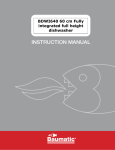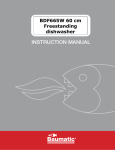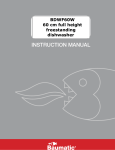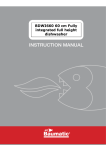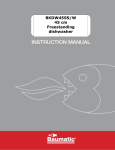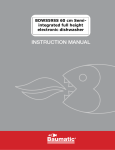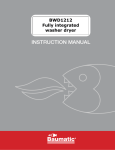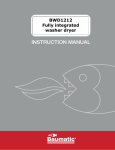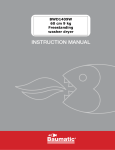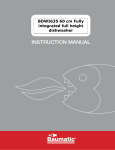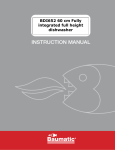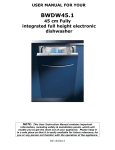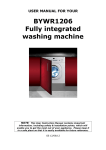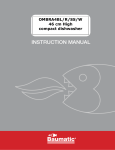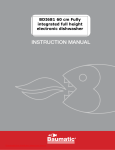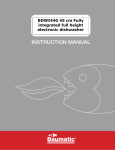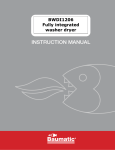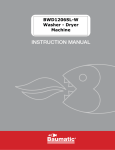Download USER MANUAL FOR YOUR BDWI600
Transcript
BDWI600-EU 60 cm Fully integrated full height electronic dishwasher USER MANUAL FOR YOUR BAUMATIC BDWI600-EU 60 cm Fully integrated full height electronic dishwasher NOTE: This User Instruction Manual contains important information, including safety & installation points, which will enable you to get the most out of your appliance. Please keep it in a safe place so that it is easily available for future reference; for you or any person not familiar with the operation of the appliance. GS 19/10/11 2 Contents Environmental note Important safety information Specifications Product and aperture dimensions Product specifications Electrical details Description of the appliance Control panel 4 5–7 8 – 11 8 9 9 10 11 Using your dishwasher Before first use Filling with dishwasher salt Setting the water softener level Filling with rinse aid Setting the rinse aid level Filling with dishwasher detergent Loading the upper basket The knife rack The cup shelves Adjusting the upper basket Loading the lower basket The cutlery basket Loading dishes and cutlery Program tables Setting a wash program Changing a wash program Adding more dishes At the end of a wash program Delay start function 3 in 1 function Saving energy using your dishwasher Cleaning and maintenance After every wash Door seals Cleaning the control panel Cleaning the door The filter system Cleaning the filters Cleaning the spray arms Error code failure system General troubleshooting Installation Aperture requirements Installation stages Preparing and connecting the furniture door Adjusting the tension of the door spring Connecting to the mains water supply Connecting to the water outlet Connecting to the power supply Applying the condensation strip Positioning the dishwasher Levelling the appliance Securing the dishwasher Installing the decorative plinth Before first use Contact details 11 11 11 13 14 15 16 17 18 18 19 20 20 21 23 25 26 26 26 27 28 28 29 29 29 29 29 30 31 32 33 35 38 38 39 40 43 44 44 45 46 46 47 48 48 49 50 - 28 – 12 – 17 - 21 - 23 - 25 – 26 - 27 – 28 - 29 – 32 - 30 – 35 – 38 - 49 – 39 – 42 - 45 - 47 - 49 3 ENVIRONMENTAL NOTE Note: Before discarding an old appliance, switch off and disconnect it from the power supply. Cut off and render any plug useless. Cut the cable off directly behind the appliance to prevent misuse. This should be undertaken by a competent person. Disable the door lock to make sure that children cannot get stuck inside the appliance. o The packaging materials that Baumatic uses are environmentally friendly and can be recycled. o Please discard all packaging material with due regard for the environment. 4 IMPORTANT SAFETY INFORMATION Your safety is of the utmost inmportance to Baumatic. Please make sure that you read this instruction booklet before attempting to install or use the appliance. If you are unsure of any of the information contained in this booklet, please contact the Baumatic Customer Care Department. General Safety o Repairs to your appliance must only be carried out by a Baumatic engineer or one of our authorised service agents. Any attempt by an inexperienced person to repair the appliance, could result in injury or damage to your dishwasher. o If you notice that the mains cable is damaged, the appliance must not be used. The same applies if you notice that the worktop, control panel or base area is damaged as this could allow access to the internal components of the machine. o The appliance should be turned off and isolated from the mains supply, before either cleaning or maintenance work is attempted. o The mains cable must not be used to pull the plug out of the electrical socket. o The machine should not be sprayed with water. o The external surface of the appliance may become hot whilst your dishwasher is in use. o It is possible for small animals to chew either mains cables or water hoses, which could cause an electric shock hazard. Installation o The installation instructions contained within this user manual should be followed. o It is obligatory for the completed installation to comply with all relevant building regulations and local water authority requirements. o Before the first use of the appliance, you should follow the steps listed in the “Before first use” section on page 10 and page 48 of this manual. 5 o Care should be taken not to trap the power supply cable underneath the appliance whilst installing it. o No attempt should be made to alter or modify the specifications of this appliance. In daily use o This appliance is only designed to wash normal domestic washloads. If you use your dishwasher in any other way or it is incorrectly used, then Baumatic accepts no liability for any damage that might be caused and any guarantee will be void. o It is recommended that the appliance is unplugged and the water supply is turned off after the machine is used. o The detergents, rinse aid and salt that you place in this appliance should be suitable for automatic dishwashers. With regards to dosage levels, the detergent manufacturer’s recommendations should be followed. o Sharp knives or ones with long blades are a potential safety hazard when placed in an upright position in the cutlery basket. We would recommend that these items are placed horizontally in the upper basket or on the knife rack. o You should not wash any items that have come into contact with corrosive, acidic or alkaline chemicals, paint, petrol, iron or steel debris. o You should not open the door whilst the appliance is set on a wash program. Depending on which stage that the wash program is at, hot water could escape the machine. o You should not leave the door of the appliance open, unless you are loading or unloading the dishwasher. o You should not stand or sit on the door when it is open. Child Safety o Your dishwasher should only be used by adults. You should not allow children in the area of the machine unsupervised. You should not let them touch the controls or play with the appliance. o It could be possible for a child or pet to gain access to the dishwasher if the door is left open. Therefore please check the inside of the appliance before setting it on a wash cycle. 6 o Any packaging that is removed from the machine should be kept away from children. o All detergents should be kept out of children’s reach in a safe place. o Some water will remain inside the dishwasher when it has completed a wash cycle. This water is not suitable for drinking and may contain residues from the detergents that are used in the appliance. Declaration of conformity This appliance complies with the following European Directives: - 73/23 dated 19/02/1973 Low Voltage Directive and subsequent modifications. 89/336 dated 03/05/1989 Electromagnetic Compatibility Directive and subsequent modifications. For future reference please record the following information which can be found on the rating plate and the date of purchase which can be found on your sales invoice. The rating plate of your dishwasher is located on the right hand side of the drop down door. Model Number ……………………………………. Serial Number ……………………………………. Date of Purchase ……………………………………. 7 Specifications Product dimensions Height: Width: Depth: 820 – 870 mm 596 mm 570 mm Aperture dimensions Height: Width: Depth: 820 – 870 mm (MIN) 600 mm 600 mm 8 Product specifications o 12 Place settings o 7 programs: Normal Intensive Economy Rapid Glass Rinse Soak o o o o o o o o o o o o o 6 temperatures: 40°C, 45°C, 50°C, 55 °C, 65°C, 70°C LED display Water consumption (normal program): 14 litres/cycle Noise level: 55 dB Delay start 3 in 1 function Residual drying Concealed heating element Self-cleaning stainless steel micro-filter Anti-leak device Anti-flood device Height adjustable upper basket Adjustable feet Energy efficiency details Energy efficiency class: A Washing performance class: A Drying performance class: A Power consumption Off mode: Left on mode: 0.00 kWh 0.75 kWh Electrical details Rated voltage: 220 - 240 Vac 50 Hz Supply connection: 13 A (double pole switched fused outlet with 3 mm contact gap) 9 Description of the appliance A) Upper basket B) Lower basket C) Middle spray arm D) Cutlery basket E) Lower spray arm F) Salt container G) Filter assembly H) Detergent and rinse aid dispenser I) Water inlet hose J) Drain hose K) Power supply cord L) Top spray arm 10 Control panel A) ON/OFF button B) Power indicator C) 3 in 1 button D) Rinse aid indicator E) Salt indicator F) Program indicators G) Program button H) 3 in 1 indicator I) Delay start indicator J) Delay start button Using your dishwasher Before first use o Install the appliance as per the installation instructions contained within this booklet. o If you are filling the salt container for the first time, fill it with tap water and then fill with specialist dishwasher salt. After this you should set the water softener level. o Fill the rinse aid dispenser and then set the rinse aid dosage. Filling with dishwasher salt IMPORTANT: You should only use salt that is specially designed for use in a dishwasher. If any other type of salt is used in the appliance (in particular table salt), it will damage the water softener. o Ideally you should fill the water softener with salt and then run a wash program. This will help to clear any salt that may have overflowed from the water softener during the salt filling process and therefore prevent the formation of rust. 11 o Open the door of the dishwasher and then remove the lower basket. The basket should be empty when you remove it. o Unscrew and remove the cap from the water softener. o Fill the container with water. IMPORTANT: It is only necessary to do this when you fill the container with salt for the first time. o Pour salt into the water softener, using the funnel that is supplied with the appliance. You should add approximately 2 kg of salt into the water softener. o It is perfectly normal for a small amount of water to come out of the water softener, whilst you are filling it with salt. This does not mean that the water softener is filled with the correct amount of salt. o Refit and fully tighten the water softener cap. o The salt indicator light (E) will go out shortly after you have filled the water softener with salt. When the salt indicator (E) lights on the control panel, then you should follow the filling with dishwasher salt procedure again. o It is recommended that you run a RAPID program, without any dishes loaded into the dishwasher, after filling with salt to remove any spilt or excess salt. o IMPORTANT: You do not need to pour water into the container when you subsequently fill the water softener with salt. 12 Setting the water softener level It is possible to regulate the amount of salt that the water softener will release during a wash cycle. The water softener should be set to a level that is appropriate for the hardness of your water (please refer to the table below). ° dH WATER HARDNESS ° fH Mmol/L 0-10 10-25 25-50 >50 0-17 18-44 45-89 >89 0-1.7 1.8-4.4 4.5-8.9 >8.9 Selector knob position / “-” MED “+” Salt consumption (grams/cycle) 0 20 40 60 Usage (cycles/2 kg) / 60 40 25 o The default setting of the water softener is “-”. o IMPORTANT: If you are using 3 in 1 dishwasher tablets and live in a medium or hard water area, then you should still fill the water softener with salt. o If you are using multifunctional tablets e.g. 3 in 1, you should fill the salt container and set the adjuster to “-”. However, if the hardness of your water is greater than 60°fH, set the adjuster to “+”. To alter the amount of salt that is released by the water softener, you should:- o Unscrew the cap from the water softener. o There is a ring on the container with an arrow on it as shown in the drawing above. o Rotate the ring in an anticlockwise direction to the required setting based on the hardness of the water being used. o When the ring is in the correct position, replace the cap on the water softener and fully tighten it. 13 Filling with rinse aid The rinse aid is released during the final rinse and it helps to prevent water from forming droplets on your dishes. These droplets will lead to spots and streaks being left on items after the wash program has completed. o Your dishwasher is designed to utilise liquid rinse aid. o The rinse aid dispenser is located inside the drop down door, next to the detergent dispenser. o To open the rinse aid dispenser, turn the cap (1) in an anticlockwise direction to allow access to the dispenser. o Pour in the rinse aid. Be careful not to overfill the dispenser, as this could cause oversudsing when a wash program is selected. Wipe away any rinse aid excess or spillages with a damp cloth. o Replace the cap and turn it clockwise until it is fully tightened. o You should refill the rinse aid dispenser when the rinse aid indicator (D) lights on the control panel. o IMPORTANT: If you are using 3 in 1 dishwasher tablets then you should still fill the rinse aid dispenser. 14 Setting the rinse aid level The amount of rinse aid that the dishwasher requires also depends on the hardness of your water. You should experiment with the rinse aid setting, until you find a level that gives the best results. o Open the rinse aid dispenser by turning the cap (1) in an anticlockwise direction. o The amount of rinse aid used for each cycle can be regulated by turning the dose adjustor (2), located beneath the dispenser cap, with an appropriate screwdriver. o There are 6 different settings to choose from. On the first wash cycle, we would recommend that the rinse aid level is set to number 3. o If you get water spots and poor drying performance, then you should turn the arrow anticlockwise and increase the setting to the next number. o You should continue to adjust the rinse aid level upwards until you get no water spots. o If you get cloudiness or streaking on your dishes, the rinse aid level is set too high and it is causing foaming during the wash cycle. Turn the arrow clockwise and lower the setting to the next number. 15 Filling with dishwasher detergent o The detergent dispenser must be refilled at the start of each wash cycle. o Always add the detergent just before starting the wash program, otherwise the detergent could get damp and not dissolve properly. o Open the lid (3) that closes over the detergent dispenser by pushing the release button (4). Place the detergent inside of the dispenser. o The section marked (5) in the diagram is for the main wash cycle detergent. Only one detergent tablet should be placed in the dispenser at any one time. If you are using detergent powder or liquid, you should follow the detergent manufacturer’s recommendations. o The section marked (6) in the diagram can have separate detergent placed in it for any wash cycle that has a pre-wash element to it, however this is optional. This must be a liquid or powder detergent, not another detergent tablet. 16 o After the detergent has been placed in the dispenser, close the cover and press it down until it clicks into place. o IMPORTANT: To enable the lid to close securely, remove any excess detergent on the edges of the dispenser before closing it. o At the beginning of a wash cycle the clip will open and the tablet/powder/liquid will enter the dishwasher. o IMPORTANT: Multifunctional tablets, such as 3 in 1, should not be used for the RINSE, RAPID or SOAK programs. Loading the upper basket The upper basket is most suited to washing delicate and light dishware, such as glasses, coffee and tea cups, saucers, plates, bowls and shallow pans (that are not heavily soiled). 1) 2) 3) 4) 5) 6) Cups Glasses Small plates Saucers Forks / knives Small bowls o You should position the dishes and cookware in such a way that they are not moved by the spray of water during the wash cycle. o Use the diagram above as a guide to the most appropriate way to load the upper basket. IMPORTANT: Care should be taken when placing long stemmed glassware, such as champagne glasses in the upper basket. If they are not positioned correctly, then there is a risk that they may topple over when the upper basket is pushed in or pulled out. 17 The knife rack o The knife rack clips onto the side of the top basket, allowing you to wash your large sharp knives separately and safely. The cup shelves o Lean tall glasses and those with long stems against the cup shelves and not against other items to be washed to help avoid damage. o Glasses, cups and small bowls can be placed on the cup shelves to provide more space in the upper basket. o The cup shelves can be folded back when not in use to allow room for larger items in the top basket. o IMPORTANT: Care should be taken to make sure that the spray arms can move freely when items have been loaded into the baskets. 18 Adjusting the upper basket Your dishwasher has an adjustable upper basket which you can alter to the most suitable position for the items you are going to wash in the upper and lower baskets. o The height of the upper basket can be adjusted by placing the wheels on a different height of the rails. Long items such as cutlery, salad servers and knives should be placed on the knife rack so they do not obstruct the rotation of the spray arms. o IMPORTANT: The upper basket must be empty when you are removing it from the guide supports. o To place the upper basket in the higher position, first open the stopper at the end of the guide supports (1) and remove the basket from the dishwasher. o Lift the basket up so that the lower wheels can slot onto the guide supports (2). o Position the lower wheels securely onto the guide supports (3) and close the stopper to secure the basket in place (4). 19 Loading the lower basket The lower basket is most suited to washing larger and more heavily soiled items, such as saucepans, saucepan lids and serving dishes. You can also load bowls and a variety of plates into the lower basket. 7) Dinner plates 8) Soup dishes 9) Dessert plates 10) Bowls 11) Cutlery basket 12) Serving platter o Use the diagram above as a guide to the most appropriate way to load the lower basket. o Saucepans and serving bowls must always be placed with their bases upwards. o Deep saucepans should be slanted, to allow water to run off. The cutlery basket Cutlery should be placed inside of the cutlery basket, separately from each other. You should take care to ensure that cutlery items are not tightly loaded as this may result in a poor wash performance. o The cutlery basket can be split in half for when there are only a small number of cutlery items to be washed, as shown in the diagram on the next page. o By only using half of the cutlery basket, this will create more space for additional pots and pans. The cutlery basket can also be placed in the upper rack when it is half the size. 20 Loading dishes and cutlery Household cloths, sponges or any other object that may absorb water SHOULD NOT be washed in a dishwasher. o Remove leftovers and soften the remnants of burnt food in pans, prior to loading dishes in the appliance. o Once the dishwasher has been loaded, check that the spray arms can move freely. If the spray arm comes into contact with any item, then you should rearrange the wash load. o Cups, glasses, pans etc should all be loaded with their bases upwards, so that water does not collect inside of them. o Cutlery and dishes should not cover each other; otherwise you may get poor wash results. o Do not allow glasses to touch inside the dishwasher, otherwise damage may occur. o Small objects can be placed inside of the cutlery basket. 21 The following items are NOT suitable for washing inside a dishwasher:o Cutlery with a handle of mother-of-pearl, wood, horn or china. o Plastic items that are not resistant to heat. o Cutlery that consists of glued parts that are not resistant to heat. o Cutlery items or crockery that are bonded. o Copper or pewter items. o Lead crystal glass. o Wooden platters. o Synthetic fibre items. The following items are not always suitable for washing inside a dishwasher:o Stoneware should only be washed if the manufacturer of the item has marked it as dishwasher safe. o Plastic items (such as lunchboxes) should only be washed if the manufacturer has marked it as dishwasher safe. o Glazed crockery may fade with repeated washing inside of a dishwasher. o Items made of silverware or aluminium can discolour when washed inside a dishwasher. o Any food residue should be removed from silver immediately, as this can also result in discolouration. items o Certain types of glass may become dull or cloudy after a large number of washes. 22 Program tables o The ECONOMY program is suitable for cleaning a typical load of dirty dishes and is the most efficient program in terms of its combined energy and water consumption. Program Type of food remnants INTENSIVE Soups, casseroles, sauces, potatoes, pasta, rice, eggs, roasts or fried food Amount of food remnants Condition of food remnants A lot. Firmly stuck on. NORMAL ECONOMY GLASS RAPID SOAK RINSE Soups, potatoes, pasta, rice, eggs, roasts or fried food. A little. Liquids e.g. coffee, milk, cold drinks Very little. Cakes, salads. Very little. Loosely attached. Loosely attached. Loosely attached. To rinse off if dishes have been stacked for several days in the dishwasher prior to washing. For dishes that need to be rinsed and dried only. Description of cycle Prewash with hot water. Extended wash at 70°C. Rinse with cold water. Rinse with hot water. Drying Prewash with cold water. Extended wash at 55°C. Rinse with cold water. Rinse with hot water. Drying. Prewash with cold water. Extended wash at 50°C. Rinse with cold water. Rinse with hot water. Drying. Wash at 45°C. Rinse with warm water. Rinse with hot water. Drying. Short wash at 40°C. Rinse with cold water. Short cold wash to prevent food residue from drying on the dishes. Rinse with hot water at 65°C. Combidetergent tablets? (e.g. 3 in 1) YES YES YES YES NO NO NO 23 Drying. Program Delay Start Detergent Pre- Main wash Rinse aid Duration (minutes)* Energy consumption (kWh) Water consumption (litres) INTENSIVE YES 5g 25g YES 122 1.44 18 YES 5g 25g YES 102 1.11 15 YES 5g 25g YES 162 1.05 14 YES - 15g YES 92 1.01 12 YES - 15g - 31 0.40 9 YES - - - 12 0.02 3 YES - - YES 55 0.90 5.5 NORMAL ECONOMY** GLASS RAPID SOAK RINSE 24 * The wash program times that are quoted are intended as a guide only. Please note that factors external to the machine, e.g. the temperature of your water supply, your water pressure etc. can affect the time it takes for the wash program to complete. ** Economy is the testing program for EN 50242. Setting a wash program Make sure that the before first use section has been followed. o Check whether the appliance needs rinse aid or salt adding to it. o Pull out the top and bottom baskets, then load them in accordance with the loading instructions. o Push the top and bottom baskets fully back into position. o Add detergent according to the instructions in this manual and turn on the water tap. o Turn the appliance on by using the ON/OFF button (A). o Press the program button (G) to choose an appropriate wash program for the load that you are washing. The relevant program indicator (F) will light to show which program you have selected. o Close the door firmly, so that you hear the door lock click shut. 25 o The chosen program indicator will flash and after a few seconds, you will hear the appliance begin to fill with water and the wash program will have started. Changing the wash program IMPORTANT: This should only be attempted when the cycle has only just started, otherwise the detergent may have already been released or you could have hot water escaping. o To cancel the current program press and hold the program button (G) for about 3 seconds. o The machine will cancel the program in progress and you can then select the required program as usual. Adding more dishes IMPORTANT: This should only be attempted when the cycle has only just started, otherwise the detergent may have already been released or you could have hot water escaping. o Open the door a little way to pause the current program. Wait until the spray arms have stopped rotating before opening the door fully. o Be careful in case hot water escapes from the interior. The dishwasher will beep ten times every thirty seconds while the door is open. o Add the forgotten dishes to the upper or lower basket. o Close the dishwasher door. After about 10 seconds the wash program will continue automatically. At the end of a wash program o Six beeps will sound to indicate that the wash cycle has completed. All of the program indicator lights (F) will turn on. o Open the door of the appliance. o Use the ON/OFF button (A) to switch the dishwasher off. o Wait for about 15 minutes before unloading the dishwasher to avoid handling the dishes and utensils while they are still hot and more susceptible to breakage. They will also dry better. 26 o It is recommended that you unload the lower basket first to avoid water dripping from the upper basket onto the dishes in the lower one. Delay start function o Check whether the appliance needs rinse aid or salt adding to it. o Pull out the top and bottom baskets, then load them in accordance with the loading instructions. o Push the top and bottom baskets fully back into position. o Add detergent according to the instructions in this manual and turn on the water tap. o Turn the appliance on by using the ON/OFF button (A). o Immediately press the delay start button (J) to select the required delay time. The delay start indicators (I) will light to show what length of time has been selected. o To cancel the delay start function at this stage, press the delay start button (J) until the delay start indicators (I) all go out. o Press the program button (G) to choose an appropriate wash program for the load that you are washing. The relevant program indicator (F) will light to show which program you have selected. 27 o Close the door firmly, so that you hear the door lock click shut. The relevant delay start indicator (I) will flash until the programmed delay start time has elapsed. o When the programmed delay start time has elapsed, the dishwasher will automatically begin the chosen wash program. 3 in 1 function o The 3 in 1 option allows you to effectively use 3 in 1 combidetergent tablets during a wash cycle. o This function can be selected when using the INTENSIVE, NORMAL, GLASS and ECONOMY programs only. o After you have loaded the dishes, added detergent and selected your wash program, press the 3 in 1 button (C). The 3 in 1 indicator (H) will light. o Close the dishwasher door and after a few seconds the wash cycle will begin. Saving energy using your dishwasher Loading dishes o Refer to the relevant section of this manual for instructions on placing items in the dishwasher for the most efficient cleaning. o Only run the dishwasher when it is full for optimum energy and water usage. o Check the program table to select the most efficient program according to the size and type of the load. o The ECONOMY program washes your items at a lower temperature and uses less water during the cycle. That is better for the environment and helps to cut energy costs as well as your water bill if you’re on a water meter. Usage o Clean the filters regularly both to keep the dishwasher clean and to maintain its efficiency. o Always remember to switch the appliance off standby when you have finished using it. £1 billion worth of energy is wasted in the UK every year by people leaving appliances on standby. 28 o You do not need to rinse dishes off before loading. If you prefer to pre-rinse, use cold water on your dishes before loading them but do not waste water by letting it run continuously. o Use the shorter and lower temperature cycles for everything but the dirtiest dishes. Shorter cycles use less energy and work just as well. Modern detergents also work just as well at lower temperatures. Cleaning and maintenance IMPORTANT: The appliance should be disconnected from your mains supply before commencing any cleaning process. After every wash o After each wash cycle has completed, you should turn the appliance off using the ON/OFF button (A). o Leave the door slightly ajar so that moisture and odours do not get trapped inside. o The door should not be left fully open to avoid a potential hazard. Door seals o One of the main factors that cause odours to form in the dishwasher is food debris that has become trapped in the door seals. o The door seals should be periodically cleaned with a damp sponge to prevent this from occurring. Cleaning the control panel IMPORTANT: Do not use any abrasive cleaner or household polish on either the control panel or operating parts. o Wipe over the control panel using a brand new damp cloth with warm water. Cleaning the door o To clean the edge around the outside of the door, you should use a soft, damp cloth only. 29 o To prevent water from penetrating the door lock or electrical components, DO NOT use a spray cleaner of any kind. o DO NOT use any abrasive cleaner or scouring pads on the inner or outer surfaces, as they may cause damage to them. The filter system Your appliance is fitted with three levels of filtering; these are located in the base of the dishwasher for ease of access. 1) Main filter 2) Coarse filter 3) Fine filter Main filter- Food and soil particles are trapped by this filter and pulverised by a special jet on the lower spray arm. This debris is then washed down the drain. Coarse filter- Larger items such as pieces of bone or glass, which could clog the drain, are trapped in this filter. Fine filter- This filter holds soil and food residue in the sump area and prevents it from being redeposited on the dishes during a wash cycle. IMPORTANT: Whilst the filtering system is efficient, your dishwasher is not a waste disposal unit. All items being washed inside of the dishwasher should have food scraps removed from them before being loaded into the appliance. 30 Cleaning the filters For best performance and results, the entire filter assembly should be thoroughly cleaned regularly (ideally after each wash cycle). 1. Rotate the coarse filter and then lift it upwards to remove. Rinse out this section under a tap to remove any food debris that remains in it. 2. Pull out the main filter and rinse this under the tap to remove any food debris that is trapped in it. 3. Pull out the fine filter and rinse this under the tap to remove any food debris that is trapped in it. 4. Place the fine filter back in its original position. 5. Place the main and coarse filter back into their original positions in the base of the dishwasher. You must rotate the coarse filter to lock it back into position. IMPORTANT: If a glass gets smashed inside of the appliance, you must check there is no glass in the filter before the machine is used again as this can cause a drainage failure. IMPORTANT: THE DISHWASHER SHOULD NEVER BE SET ON A WASH CYCLE WITHOUT THE FILTERS BEING INSIDE OF THE APPLIANCE. 31 Cleaning the spray arms The spray arms should be cleaned regularly, to prevent hard water deposits from clogging the spray arm jets and bearings. o To remove the upper spray arm (4), hold the nut and rotate the arm to remove it. o To remove the lower spray arm (5), gently pull it upwards. o Wash the spray arms in warm, soapy water and use a soft brush to clean the jets. o Rinse the spray arms thoroughly and then reassemble the spray arms back in their original positions. Ensure that the lower spray arm (5) has locked into place and the upper spray arm (4) is screwed tight. 32 Error code failure system If your appliance senses that it is not operating correctly, then a program indicator light may flash. The following error codes can possibly be remedied by the customer and the steps outlined below should be followed. BEFORE COMPLETING ANY MAINTAINEANCE ON THE APPLIANCE, IT SHOULD BE DISCONNECTED FROM YOUR MAINS POWER SUPPLY. INTENSIVE, NORMAL and ECONOMY program indicators flash. Longer than expected fill time. Check the water pressure of your mains water supply. Clean the mesh filter that sits in the inlet hose. Ensure that the inlet hose is not kinked or crushed. Make sure the water tap that the machine is connected to is turned on fully. 9 Check the inlet hose is connected properly. o 9 9 9 9 INTENSIVE, ECONOMY AND GLASS program indicators flash. o The machine has sensed water in the base. 9 Check that the outlet hose is not kinked or crushed. 9 Check that there are no blockages in the drain hose or the drainage system that the appliance is connected to. 9 The drain pipe may be placed in too high a position or incorrectly. Check the installation instructions and ensure that the installation is correct. 33 INTENSIVE AND ECONOMY program indicators flash. o The machine has sensed water in the base. 9 The drain pipe may be placed in too low a position or incorrectly. Check the installation instructions and ensure that the installation is correct. o Once you have taken action to rectify the problem that has caused the fault code to appear, plug the machine back into your mains power supply. o Turn the machine on using the ON/OFF button (A) and set a wash program, using the program button (G). IMPORTANT: If any other program indicators flash, you should not attempt to clear it yourself and contact the Baumatic Customer Care Department. IF THE FAULT CODE REAPPEARS AFTER FOLLOWING THE ABOVE ADVICE AND CLEARING THE FAULT CODE. YOU SHOULD TURN OFF THE APPLIANCE; DISCONNECT THE APPLIANCE FROM YOUR MAINS SUPPLY. THEN ARRANGE FOR AN ENGINEER TO ATTEND THE APPLIANCE. YOU SHOULD CONTACT THE BAUMATIC CUSTOMER CARE LINE ON TELEPHONE NUMBER (0118) 933 6933. Please note that if an engineer is asked to attend whilst the product is under guarantee and finds that the problem is not the result of an appliance fault, then you may be liable for the cost of the call out charge. The appliance must be accessible for the engineer to perform any necessary repair. If your appliance is installed in such a way that an engineer is concerned that damage will be caused to the appliance or your kitchen, then he will not complete a repair. This includes situations where appliances have been tiled in, sealed in with sealant, have wooden obstructions placed in 34 front of the appliance, like plinths. Or any installation other than the one specified by Baumatic has been completed. Please refer to the conditions of guarantee that appear on the warranty card that you receive with the appliance. IMPORTANT: Baumatic Ltd operates a policy of continuous improvement and reserves the right to adjust and modify its products without prior notification. General troubleshooting PROBLEM The lower spray arm does not rotate properly. The detergent compartment lid can not be closed. The program indicator lights do not turn off after a wash cycle is complete. Remnants of detergent are stuck inside the dispenser. Water remains inside the appliance after a program has ended. There is an unusual amount of suds in the dishwasher. POSSIBLE CAUSES The spray arm is blocked by food remains or a foreign object. WHAT TO DO Clean the spray arm using the instructions in this manual. The path of the spray arm is blocked by an item in the lower basket. The detergent compartment has been overfilled. Rearrange items in the lower basket. The hinge mechanism is clogged with remnants of detergent. The appliance is still turned on. Use a clean damp cloth to remove any detergent residues from the container. Use the ON/OFF button (A) to turn the dishwasher off. The detergent compartment was damp when it was filled with detergent. A blockage or kink in the drain hose. The detergent compartment must be dry before detergent is added to avoid it sticking. The filters are blocked. Clean the filter assembly by following the relevant instructions. The program is still running. Incorrect detergent used. Wait for the program to end. Spilled rinse aid has got into the wash cycle. Wipe up any rinse aid spills before beginning a wash cycle to avoid excessive foaming. If this occurs, open the dishwasher Follow the manufacturer’s instructions for correct amount of detergent to use. Check the drain hose for kinks or blockages. Use only special dishwasher detergent and follow the manufacturer’s instructions with regards to dosages. 35 The appliance abruptly stops during a wash program. Cut off electricity supply to the appliance. A knocking sound can be heard in the dishwasher during a program. A rattling sound can be heard in the dishwasher during a program. A knocking sound can be heard coming from the inlet valves. Remnants of food are stuck to the dishes and cutlery. A spray arm is knocking against the dishes inside the appliance. The water supply has been interrupted. door and pour in 1 litre of cold water. Then run a RINSE program to clear the suds. Repeat if necessary. Reconnect the electricity supply or wait for power to return. Check the inlet hose is connected properly and the tap is turned on and working. Rearrange items in the upper and/or lower basket according to the loading instructions in this manual. The crockery has not been stacked properly in the baskets. Rearrange items in the baskets according to the loading instructions in this manual. This is caused by the way the water pipes have been laid. This has no effect on the workings of the dishwasher so no remedy is necessary. If you are in any doubt, please contact a suitably qualified plumber. Follow the loading instructions in this manual for correctly loading the baskets. The dishwasher was not loaded properly so jets of water could not reach all parts of the dishes. Baskets were overfilled. Place less items in the dishwasher baskets. Items in the baskets were touching each other. Space the items out so they are not touching each other. Not enough detergent was placed in the dispenser. Increase the amount of detergent used. The selected wash program was not strong enough. Choose a more intensive program. The rotation of the spray arm(s) was blocked by dishes. Rearrange items in the baskets. Nozzles in the spray arms are blocked by remnants of food. Clean the spray arms by following the instructions. The filters are blocked. Clean the filter assembly by following the instructions. The filters have been Check the filters are correctly in 36 Plastic items are discoloured. White film on crockery and glasses. Poor drying results. fitted incorrectly. position. Not enough detergent was used. Increase the amount of detergent used. Incorrect detergent was used. Use only special dishwasher detergent. Items are not suitable for washing in the dishwasher. Do not wash these items in the dishwasher and look for dishwasher-safe replacements in the future. Use more detergent. Not enough detergent was added to the dispenser. Rinse aid level was too low. Increase the rinse aid level. Salt container is empty. Fill the salt container by following the instructions. Water softener was set too low. Alter the water softener setting. The lid on the salt container is loose. Ensure the salt container lid is securely tightened before starting the wash program. Choose a program which contains a drying section by referring to the program table. The selected program did not include a drying section. The rinse aid level was set too low. Increase the rinse aid setting. Items were removed from the dishwasher too soon. After a program has completed, open the dishwasher door slightly and leave for 15 minutes before unloading. This will allow items to cool down and dry. Increase the rinse aid level. Glasses have a dull appearance. Rinse aid level set too low. Tea stains or traces of lipstick have not been completely removed. Incorrect detergent used. Choose a different brand / type of detergent. Washing temperature was too low. Traces of rust on the cutlery. Cutlery is not sufficiently rust-proof or not suitable for washing in a dishwasher. Choose a program which reaches a higher temperature or is more intense by referring to the program table. Do not wash these items in the dishwasher and look for dishwasher-safe replacements in the future. Salt content in washing water is too high. Check that the salt container lid is closed securely. 37 Remember to run a RINSE program after filling with salt to wash away any excess. Glasses are clouded and discoloured by a coating that cannot be wiped off. Unsuitable detergent was used. Change the detergent brand / type. Glasses are not dishwasher-safe. Smears left on glasses and cutlery has a metallic appearance. Rinse aid level is too high. Do not wash these items in the dishwasher and look for dishwasher-safe replacements in the future. Lower the rinse aid level setting. Installation IMPORTANT: THIS INSTALLATION MUST BE COMPLETED BY A SUITABLY QUALIFIED PERSON. BAUMATIC ONLY SANCTION THE INSTALLATION GIVEN IN THIS INSTRUCTION MANUAL. YOU SHOULD DISPOSE OF ALL PACKAGING IN AN ENVIRONMENTALLY FRIENDLY MANNER. Aperture requirements 38 o The aperture that your dishwasher needs to be installed into should resemble the one shown in the drawings above and on the previous page. o There should be less than a 5 mm gap between the top of the dishwasher and the underneath of the worktop. The height of the aperture required will vary between 820 – 870 mm depending on the height of the adjustable feet. Installation stages 1. Preparing and connecting the furniture door. 2. Adjusting the tension of the door spring. 3. Connecting to the mains water supply 4. Connecting to the water outlet 5. Connecting to the power supply 6. Applying the condensation strip 7. Positioning the dishwasher 8. Levelling the dishwasher 9. Securing the dishwasher 10. Installing the decorative plinth 39 Preparing and connecting the furniture door o IMPORTANT: The furniture door is not supplied with the appliance. You should purchase one to match with the rest of your kitchen cabinets. o The maximum weight of the furniture door should be 5.5 kilograms. The furniture door should have a maximum height of 725 mm and a maximum width of 598 mm. The maximum thickness of the furniture door should be 20 mm. o Use the installation template supplied with the appliance to mark up and then drill out the necessary holes in the furniture door. o Align the top edge of the template (A) with the top edge of the furniture door and the left hand edge of the door in line with the measured door width. o Mark the positions for the four fixing positions with a pencil. Repeat this step on the right hand side of the door using the template. o At the eight positions marked, drill holes which are 2 mm in diameter. Take care not to drill through the door. If the door is made of chip board, only drill through the veneer. If the door is made of solid wood, the holes can be made deeper. o Attach the lower fixing brackets to the bottom part of the door. 40 o The upper plastic studs should be attached to the top of the décor door. o Lift the furniture door towards the dishwasher door and locate the two plastic studs mounted at the top of the décor door. 41 o Lift the décor door until the lower brackets locate into the slots in the appliance door. Align the top of the décor door with the adjacent cabinets. o Open the dishwasher door carefully while supporting the décor door. o Remove the small plastic plugs that cover the holes on the inside of the dishwasher door and fasten the furniture door in place with the screws provided. Remember to cover the two holes with the plastic plugs removed earlier. 42 Adjusting the tension of the door spring o The door of the dishwasher is attached to springs. These are set at the factory to ensure that they are at the proper tension, so that the door can open and close smoothly. o After the furniture door has been fitted, you will need to adjust the tension of the door spring. o Rotate the adjusting screws at the top of the dishwasher, shown in the image above, to either tighten or slacken the steel cable. o The doors’ spring tension is correct when:a) The door remains horizontal when in the fully opened position. b) You are able to shut the door easily, by raising the door using your fingers. o WARNING: If you do not adjust the tension of the door spring, then it could cause damage to the appliance. 43 Connecting to the mains water supply IMPORTANT: Do not connect the appliance to your mains water supply using an old or an existing water inlet hose. The inlet hose supplied with the dishwasher is the ONLY one that should be used. o The inlet hose will be located inside the cabinet of the dishwasher. o Connect the water inlet hose to a cold threaded water tap that has a 3/4” thread and to the inlet hose connector on the appliance. o Let the water run to make sure the water is clear and free of impurities to prevent blocking the inlet hose or damaging the appliance. o Fully tighten the inlet hose to the water tap and the dishwasher. Connecting to the water outlet o Secure the drain hose, so that it cannot move whilst the dishwasher is in use. o Insert the drain hose into a drain pipe with a minimum diameter of 40 mm or let it run into the sink, making sure to avoid bending or crimping it. o If necessary, fit a U-bend with a connecting piece for the drain hose (A). The connecting piece must be securely fastened to the 44 wall to prevent the drain hose from moving and allowing water to spill outside the drain. o The free end of the hose must be at a height of between 400 and 1000 mm and must not be immersed in water. o IMPORTANT: Do not insert the drain hose too deeply into the pipe, as this may cause siphoning. o NEVER EXTEND THE DRAINAGE HOSE FROM ITS ORIGINAL LENGTH. Connecting to the power supply o IMPORTANT: The electrical socket must still be accessible once the appliance is installed. o Consult the rating plate, located on the right hand side of the drop down door BEFORE making the electrical connections. Ensure that the voltage reaching the plug is the same as that on the rating plate. o DO NOT REMOVE THE RATING INFORMATION ON IT IS IMPORTANT. PLATE AS THE o The moulded plug that is supplied with the appliance must be placed into an earthed and insulated socket. o Broken or damaged power leads must only be replaced by a suitably qualified person. A power lead of a similar type must be used in replacement. o Power lead type – H 0 V V – F 3G 1,5. o IMPORTANT: We do not recommend that this appliance is connected to an extension lead. 45 Applying the condensation strip o The condensation strip must be fitted to the underside of the worktop to protect it against the ingress of moisture. The strip will deflect steam that rises from your appliance, away from the underneath of the worktop. o The condensation strip will be located inside of your dishwasher. o Ensure that the underneath of the worktop is clean before sticking the strip to it. o Separate the backing paper away from the strip (I). o Stick the condensation strip to the underneath of the worktop (II). o IMPORTANT: Failure to attach the condensation strip could result in damage to your worktop. Positioning the dishwasher 46 o Carefully slide the dishwasher back into position, underneath the worktop. o Level the appliance, by following the instructions below, so that the top part of the appliance comes into contact with the underside of the counter for fastening. Levelling the appliance o IMPORTANT: Your dishwasher must be level for it to operate properly. You can adjust the appliance to account for any unevenness in the floor surface. o Make sure that the dishwasher is supported whilst it is being levelled, otherwise it may tip over. o The height of the appliance can be adjusted using the screws (A) located at the bottom of the appliance, as shown in the diagram below. o Use a screwdriver to turn the screws in a clockwise direction to raise the dishwasher and in an anticlockwise direction to lower it. o Check that the appliance is level from side to side. o Check that the appliance is level from front to back. 47 Securing the dishwasher The dishwasher must be secured to the worktop, this can be done in one of two ways:o Standard worktop- Secure the dishwasher to the underside of the worktop via the two fixing holes in the top trim. o These screws should be fully tightened. o Marble/granite worktop- The material of the worktop will mean that it is impossible to put a screw through the underneath of the worktop. o Two brackets are provided to allow the appliance to be secured to the sides of the adjacent cabinets. o The brackets should be secured to the appliance using the two screws at the top of the chassis, adjusted to the correct width and then screwed to the adjacent side panels using suitable screws. Installing the decorative plinth o A decorative plinth can be installed at the base of the dishwasher according to the manufacturer’s instructions. o When the plinth is in position, slowly open the dishwasher door to check that the door does not hit or rub against the plinth. 48 o If it does, rest the bottom edge of the décor door on the plinth and mark the part to be cut. There should be a cut out in the plinth to provide a minimum gap of 3 mm between the bottom of the décor door and the plinth to allow the door to move freely. o Remove the plinth and trim as necessary. You may wish to seal the edges of the plinth with a suitable varnish to prevent water ingress. Replace the plinth. Before first use You should check the following before using the appliance for the first time:o o o o o o o o That That That That That That That That the dishwasher is level and fixed in position. the water tap is fully open. there are no leaks at either end of the drain or inlet hoses. the inlet and outlet hose are fully tightened. the inlet and outlet hoses are not kinked. the power is switched on. the water softener has been filled with water and salt. the rinse aid dispenser has been filled. 49 United Kingdom Baumatic Ltd., Baumatic Buildings, 6 Bennet Road, Reading, Berkshire RG2 0QX United Kingdom Czech Republic Baumatic CR spol s.r.o. Lípovà 665 460 01 Liberec 4 Czech Republic +420 483 577 200 www.baumatic.cz Sales Telephone (0118) 933 6900 Sales Fax (0118) 931 0035 Customer Care Telephone (0118) 933 6911 Customer Care Fax (0118) 986 9124 Spares Telephone (01235) 437244 Advice Line Telephone (0118) 933 6933 Slovakia Baumatic Slovakia, s.r.o. Galvániho 7/D Slovakia E-mail: [email protected] [email protected] [email protected] [email protected] +49 5221 694 99-0 +421 255 640 618 Germany Baumatic Gmbh Lilienthalstrasse 1 320 52 Herford Deutschland www.baumatic.de Website: www.baumatic.co.uk Italy Baumatic Italia S.R.L. Via Galvani N.3 35011 Campodarsego (PD) Republic of Ireland +3904 9920 2297 Service Telephone 1-890 812 724 www.baumatic.it Spares Telephone 091 756 771 Holland Baumatic Benelux B.V. Grindzuigerstraat 22 1333 MS ALMERE Nederland +3136 549 1555 www.baumatic.nl 50 51 52






















































